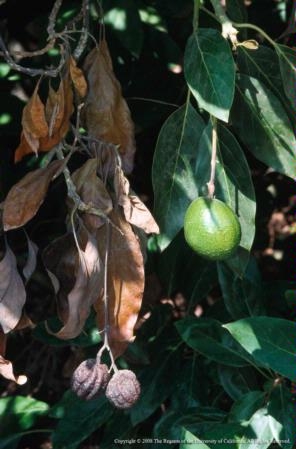Diseases, disorders and other plant problems are critical concerns
for the wholesale nursery. These include biotic problems — caused by
living organisms such as pathogens, nematodes, and insects and other
arthropods — as well as abiotic problems — caused by factors such as
temperature and moisture extremes, mechanical damage, chemicals,
nutrient deficiencies or excesses, salt damage and other environmental
factors. Many plant problems, especially biotic problems, if not
recognized and controlled early in their development, can result in
significant economic damage for the producer. Therefore, timely and
accurate diagnoses are required so that appropriate pest and disease
management options and other corrective measures can be implemented.
Definition of Plant Diagnosis and Steps
Diagnosis is the science and art of identifying the agent or cause of
the problem under investigation. When one renders a diagnosis, one has
collected all available information, clues and observations and then
arrives at an informed conclusion as to the causal factor(s). Hence,
plant problem diagnosis is an investigative, problem-solving process
that involves the following steps:
- Ask and answer the appropriate questions to define the problem and
obtain information that is relevant to the case under investigation.
- Conduct a detailed, thorough examination of the plants and production areas.
- Use appropriate field diagnostic kits and lab tests to obtain clinical information on possible causal agents and factors.
- Compile all the collected information and consult additional resources and references.
- Finally, make an informed diagnosis.
Throughout this process compile all notes, observations, maps,
laboratory results, photographs and other information. This compilation
will be the information base for the present diagnosis and can also be a
useful resource for future diagnostic cases. Keep an open mind as the
information is analyzed and do not make unwarranted assumptions.
Distinguishing Abiotic and Biotic Problems
The first step is to determine whether the problem is caused by an
infectious agent, and this can be difficult. Plant symptoms caused by
biotic factors such as infectious diseases and arthropod pests are often
similar to damage caused by other factors. Leaf spots, chlorosis,
blights, deformities, defoliation, wilting, stunting and plant death can
be common symptoms of both biotic and abiotic problems; therefore, the
presence of these symptoms does not necessarily mean the problem is a
disease. Some general guidelines for distinguishing abiotic and biotic
problems follow and are summarized in table 1.
Table 1 DISTINGUISHING ABIOTIC AND BIOTIC PROBLEMS |
||
Characteristics |
Abiotic |
Biotic |
Hosts |
often affects several species or plants of various ages |
often affects one species or cultivar of the same age |
Pattern of plant symptoms |
often related to environmental or physical factors or cultural practices; may be regular or uniform |
often initially observed in random or irregular locations |
Rate of symptom development |
relatively uniform, extent of damage appears similar among plants |
relatively uneven, time of appearance and damage severity varies among affected plants |
Signs |
no evidence of the kinds of pests or pathogens known to cause the current symptoms |
presence of insects, mites, |
Spread |
is not infectious, is not progressive, commonly caused by one incident and does not spread |
infectious, spreads on host over time if environmental conditions are suitable |
Recurrence |
possibly previously associated with current or prior environmental conditions or cultural practices |
possibly caused by pests that |
Adapted from Table 18, ANR Pub 3420 |
||
Biotic problems. Identifying
biotic problems is sometimes facilitated if signs of a pathogen,
primarily the growth of a fungus, are present. The most obvious
examples of such signs are the mycelium and spores produced by rusts and
powdery and downy mildews. However, in other cases nonpathogenic fungi
can grow on top of damaged plant tissues and appear to be signs of a
pathogen, resulting in possible misdiagnoses.
Biotic problems often affect one species or cultivar of the same age
and typically are initially observed in random or irregular locations;
symptoms appear at varying times, and severity varies among affected
plants. Biotic problems are infectious, spreading when environmental
conditions are favorable, and may be associated with pests that have
affected the crop. This infectious aspect is important, as biotic
diseases will many times be progressive and continue to affect
additional tissues and more plants.
Abiotic problems. In contrast to biotic
factors, abiotic problems often affect several species or plants of
various ages; typically, damage is relatively uniform, doesn't spread
and is often not progressive. Abiotic problems are not associated with
pests. They are often caused by a single incident and are related to
environmental or physical factors or cultural practices. Once the
responsible factor has dissipated and is no longer affecting the plant,
the plant may grow out of the problem and develop new, normal appearing
foliage.
Diagnosing Biotic Problems
Infectious diseases. To confirm if
a problem is caused by a pathogenic fungus, bacterium, nematode, or
virus, it is often necessary to have symptomatic tissues analyzed by a
trained horticulturalist or plant pathologist. Such experts will
attempt to microscopically observe the agent and recover it, if
culturable, through isolation procedures. Lab analysis is particularly
important to determine if multiple pathogens are infecting the plant. A
downside is that obtaining a diagnosis from lab analysis is not a fast
process. However, quick test kits (fig. 1A) are available that can be
used to rapidly identify many common diseases in the field. (Editors'
note: See Steve Tjosvold's regional report for more details.)
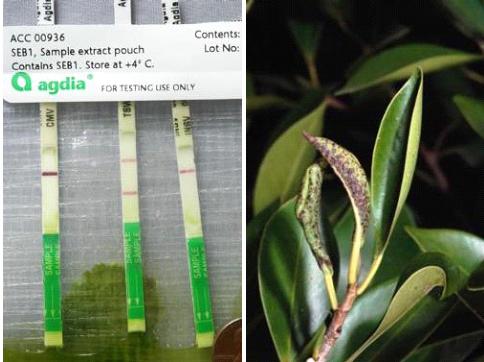
A B
Fig.1. Diagnosing biotic
problems. Plant pathogens can sometimes be rapidly diagnosed using
commercially available quick tests, such as these test strips for
viruses (A). Arthropod pests such as Cuban laurel thrips (shown here on Ficus) cause feeding damage, which can help in pest identification (B). Photos: S.T. Koike (A), J. K. Clark (B).
It is worthwhile to emphasize that diagnosing plant diseases requires
careful examination of the entire plant specimen. Symptoms on leaves,
stems, or other above ground plant parts might lead one to suspect that a
foliar pathogen is involved. However, these symptoms could also result
if the roots are diseased. Therefore, it is important to conduct a
complete examination of the symptomatic plant.
Because biotic diseases are caused by living microorganisms, the
collecting and handling of samples is particularly critical. Samples
that are stored for too long a time after collecting or that are allowed
to dry out or become hot (if left inside a vehicle, for example) will
sometimes cause the pathogen in the sample to die, making pathogen
recovery and identification impossible. Plants that have been diseased
for a long time and that are in the late stages of disease development
will often be colonized by nonpathogenic saprophytic organisms. If
these tissues are collected, it will be difficult to recover the primary
pathogen of concern because of the presence of these secondary decay
organisms. Root samples should be collected carefully as diseased roots
are sometimes difficult to dig out of the potting mix or soil, are
usually colonized by the pathogen as well as secondary agents, and are
very sensitive to high temperatures and drying conditions.
Arthropod and other invertebrate pests. Insects,
mites, slugs and snails cause damage while feeding on the plant (fig.
1B). Feeding damage is usually associated by the type of feeding
characteristics and mouthparts of the insect or pest. For example,
mites and insects such as whiteflies, aphids and mealybugs have tubular
sucking mouthparts that suck plant fluids, causing buds, leaves, or
flowers to discolor, distort, wilt, or drop. Thrips have rasping
mouthparts that result in dried out, bleached plant tissue.
Caterpillars, weevils, snails and slugs have chewing mouthparts that
make holes and cuts in foliage or flowers. They can also prune plant
parts and sometimes consume entire plants.
If present, these pests are visible with the naked eye, a 10 X hand
lens, or stereomicroscope, all depending upon their size. An
assessment of whether the identified arthropod or invertebrate matches
the plant damage it is associated with must be determined. Sometimes
the identified arthropod or invertebrate may not be the sole problem or
could, in fact, be a beneficial organism or insignificant pest.
Aphids, whiteflies, thrips, leafhoppers and some other insects that
suck plant juices may vector pathogens such as viruses and phytoplasmas
(and to a lesser extent fungi and bacteria). They can feed on infected
plants, acquire the pathogen, feed on healthy host plants and transmit
the pathogen to the new host. The insects do not necessarily have to be
present in large numbers to cause a significant disease outbreak. The
insect vectors are not always present at the same time the disease
symptoms are being expressed.
The excrement and byproducts from these pests can also provide clues
that the pests have been or are actively present. Caterpillars and
other chewing pests produce dark excrement or droppings. Greenhouse
thrips and plant bugs produce dark, watery, or varnish-like droppings on
foliage. Aphids, whiteflies, soft scales, and some other sap-sucking
insects excrete excess plant fluids as honeydew, a sticky sap, which
provides a medium for the growth of sooty mold.
Diagnosing Abiotic Problems
Nutrient deficiencies and toxicities. Nutrient
deficiencies and toxicities reduce shoot growth and leaf size, cause
leaf chlorosis (fig.2A), necrosis and dieback of plant parts. However,
nutrient deficiencies cannot be reliably diagnosed on the basis of
symptoms alone because numerous other plant problems can produce similar
symptoms. There are general symptoms that can be expressed by
deficiencies of nutrients but usually leaf and/or soil samples are
needed to confirm the problem.
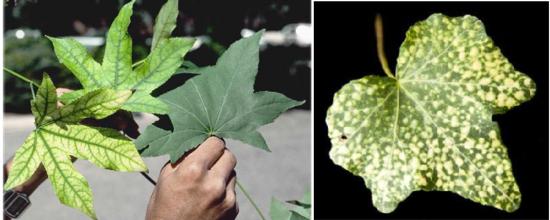
A B
Fig. 2. Examples of abiotic problems. Iron deficiency on sweet gum (Liquidambar styracifolia) showing interveinal chlorosis (A). Chorotic spots on Hedera caused by a miticide application at a higher dosage rate than specified on the pesticide label (B). Photos: E. Martin (A), S. A. Tjosvold (B).
Herbicide, insecticide and fungicide phytotoxicity. Herbicides
used to control weeds in crops or in non-cropped areas sometimes injure
ornamental crops when they are not used in accordance with label
instructions. Examples include when an herbicide is used in or around
sensitive non-target crops, when an herbicide rate is increased above
tolerable limits, or when an applicator makes a careless application.
By understanding the mode of action of the herbicide, one can determine
if the symptom fits an herbicide application. Herbicide detection in
affected plants is possible with the help of a specialized laboratory
but the analysis can be expensive. To minimize the cost of testing, the
laboratory will need to know the suspected herbicide or its chemical
group to narrow the analysis.
Insecticides and fungicides occasionally cause obvious plant damage.
Symptoms can vary widely. Generally, flower petals are more
susceptible to damage from pesticide applications than are leaves. The
younger and more tender the leaves the more susceptible they are to
pesticide applications. Hot weather can exacerbate the damage the
chemicals cause. Pesticides that have systemic action can have a more
profound effect. Some active ingredients can adversely affect the
photosynthetic mechanism or other physiological processes and can result
in a general leaf chlorosis, interveinal chlorosis, leaf curling and
stunting. Emulsifiable concentrate (EC) formulations, soaps and oils
can adversely affect the waxy surface layer that protects the leaf from
desiccation. Applications with these products can result in the loss of
the shiny appearance of a leaf, leaf spotting and necrosis. Pesticides
applied as soil drenches can cause poor germination, seedling death, or
distorted plant growth.
Check label precautions against use on certain species. Make sure the
pesticide is not applied more frequently or at a higher rate (fig. 2B)
than recommended, or that the pesticide is not mixed with incompatible
pesticides. When in doubt as to whether the plant species is sensitive
to the pesticide, spray a few plants and observe them for several days
to a week for any signs of damage before spraying any more of the
plants.
Physiological and Genetic Disorders
There are numerous disorders that can occur because of environmental
extremes — too much or too little of an environmental element such as
light, temperature, water, or wind. Sunburn is damage to foliage and
other herbaceous plant parts caused by a combination of too much light
and heat and insufficient moisture. A yellow or brown area develops on
foliage, which then dies beginning in areas between the veins. Sunscald
is damage to bark caused by excessive light or heat. Damaged bark
becomes cracked and sunken. Frost damage causes shoots, buds and
flowers to curl, turn brown or black and die. Hailstones injure leaves,
twigs, and in serious cases even the bark. Chilling damage in
sensitive plants can cause wilting of foliage and flowers and
development of dark water-soaked spots on leaves that can eventually
turn light brown or bleached, and die. Physical and mechanical injury
can occur when plants are mishandled during transport or routine
cultural practices. Wounds might serve as entry sites for plant
pathogens and can attract boring insects to woody stems.
In closed environments such as greenhouses and nursery storage areas,
plants can be exposed to toxic levels of ethylene gas. Sources of
ethylene include improperly functioning or unvented greenhouse heaters;
exhaust from engines of forklifts and vehicles; cigarette smoke;
damaged, decaying, or dying plants; and ripe or decaying fruit. Toxic
levels of ethylene gas can cause premature abscission of flower buds,
petals (fig. 3) and leaves. Other symptoms include wilted flowers,
chlorosis, twisted growth or downward bending of stems and leaves and
undersized or narrow leaves.
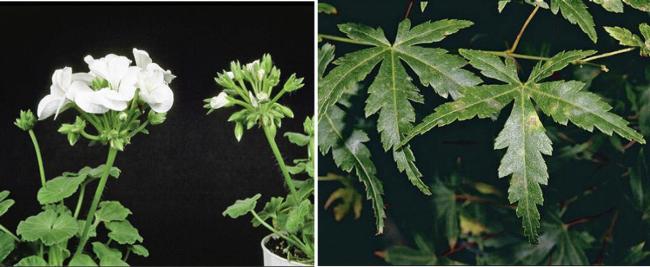
A B
Fig. 3. Poor air quality can
lead to physiological disorders. Shattering (petal drop) on geranium was
caused by plant exposure to low levels of ethylene in the greenhouse or
during postharvest storage (A). Yellowish and brownish patches on
Japanese maple leaves are damage caused by ozone (B), an outdoor air
pollutant. Photos: J. K. Clark.
Outdoors, exposure of nursery plants to air pollutant gases such as
ozone (fig. 3), carbon monoxide, nitrous oxides and sulfur dioxide can
cause damage. Typical symptoms vary widely, but include slow growth and
discolored, dying, or prematurely dropping foliage. Damage is often
found where plants are located near sources of polluted air such as near
freeways or industries or where weather and topography concentrate the
pollutants.
Sometimes plants or plant shoots exhibit an unusual and sudden change
of color producing discrete markings of variegation. For example, a
plant with entirely green leaves suddenly produces a shoot that has
leaves with edges lacking green pigment, stripes, or blotches. A new
shoot such as this is probably a chimera (fig. 4). It is produced when a
genetic mutation occurs in a specific region of the growing tip
resulting in a section with genetically different cells. The ostensible
result of the genetic change is dependent on the arrangement of the
genetically different cells in the shoot tip and their expression. This
can lead to sometimes bizarre variegation forms or sometimes forms that
are quite desirable. Sometimes variegation can be caused by viruses.
Viruses usually cause non-uniform chlorosis, such as mosaics, while
chimeras usually produce patterned forms such as variegation of color on
leaf margins, stripes, or complete loss of pigment. Some viroids may
also cause bleaching of pigments in leaves; such symptoms, however, are
generally produced throughout the plant and are not restricted to a
single shoot. Some nutrient disorders can cause variegation but these
disorders usually do not arise from a specific shoot as with chimeras.
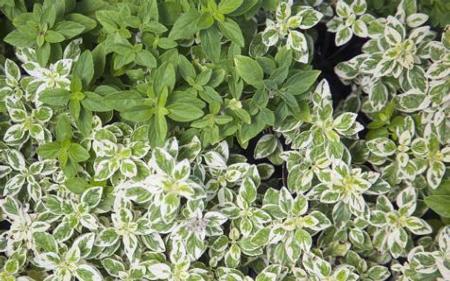
Fig. 4. Genetic disorder.
Growing points with variegated leaves can sometimes arise spontaneously
from some species such as this Origanum. Genetic variants such as this are sometimes confused with plants with virus disease or nutrient deficiency symptoms. Photo: S. A. Tjosvold.
Steve Tjosvold is Environmental Horticulture Advisor and
Steve Koike is Plant Pathology Farm Advisor, UC Cooperative Extension,
Santa Cruz and Monterey counties.
This article was condensed from: Diagnosing Plant
Problems, Chapter 11. In Newman, J. (ed) Container Nursery Production
and Business Management. Univ. of Calif. Agric. and Nat. Resources.
Publication 3540. Richmond, CA.
References
Boger P, Sandmann G. 1989. Target sites of herbicide action. Boca Raton, FL: CRC Press.
Costello L, Perry E, Matheny N, Henry M, Geisel P. 2003. Abiotic
disorders of landscape plants: A diagnostic guide. Oakland: University
of California Division of Agriculture and Natural Resources Publication
3420.
Derr JF, Appleton BL. 1988. Herbicide injury to trees and shrubs: A
pictorial guide to symptom diagnosis. Virginia Beach, VA: Blue Crab
Press.
Dreistadt SH. 2001. Integrated pest management for floriculture and
nurseries. Oakland: University of California Division of Agriculture and
Natural Resources Publication 3402.
Eagle, DJ. 1981. Diagnosis of herbicide damage to crops. New York, NY: Chemical Publishing Co.
Grogan RG. 1981. The science and art of plant disease diagnosis. Annual Review of Phytopathology 19:333–351.
Retzinger EJ, Mallory-Smith C. 1997. Classification of herbicides by
the site of action for weed resistance management strategies. Weed
Technology 11:384–393.
Schubert TS, Breman LL. 1988. Basic concepts of plant disease and how
to collect a sample for disease diagnosis. Plant Pathology Circular No.
307. Florida Department of Agriculture and Consumer Services, Plant
Pathology Circular No. 307.
Sharma MP. 1986. Recognizing herbicide action and injury. Alberta Environmental Centre, Alberta Agriculture. Agdex 641–647.
Shurtleff MC, Averre CW. 1997. The plant disease clinic and field
diagnosis of abiotic diseases. St. Paul, MN: American Phytopathological
Society Press.
Stewart TM, Galea VJ. 2006. Approaches to training practitioners in
the art and science of plant disease diagnosis. Plant Disease
90:539–547.
Tickes B, Cudney D, and Elmore C. 1996. Herbicide injury symptoms.
Tucson, AZ: University of Arizona Cooperative Extension Publication No.
195021.
Attached Images:
